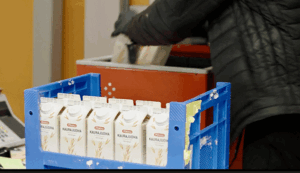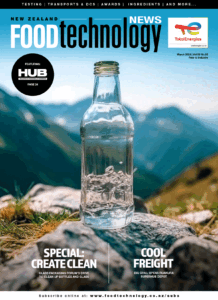 Consumer behaviours are in flux, changing in response to economic factors and the adoption of new technologies.
Consumer behaviours are in flux, changing in response to economic factors and the adoption of new technologies.
“For businesses in the supply chain – including manufacturers, retailers and warehouse owners – it’s essential to adapt to changing consumer habits, or risk being left behind,” states Jason Wu, business development manager, AutoStore Australia and New Zealand.
“At the same time, the supply chain is under pressure amid rising costs, increased competition and a more complex business landscape. Businesses are trying to balance the consumer changes, with finding solutions to these challenges, too.”
Inflation and rising interest rates have pushed up the cost of everyday essentials, including groceries, rent and fuel. As a result, Australians are making lifestyle adjustments and shopping more cautiously.
Wu points to the latest CommBank Consumer Insights report, which finds that Australians have reduced their spending on discretionary goods, so they can cover the costs of essentials (like food and fuel) and household bills, including utilities and mortgage repayments. “A 66% majority of Australian shoppers are researching more before they buy, with many of them favouring online search tools to do so. A further 74% of Australians admit to relying more heavily on loyalty rewards, promotions and vouchers,” says Wu.
He points out that digital technology holds the key, helping retailers present shoppers with price comparison platforms, personalised discounts or vouchers, and loyalty benefits. “Shoppers are looking for value, without having to compromise on a great shopping experience, good customer service or safety.”
(SUB)Shoppers demand more choice, greater flexibility
Not only do consumers want access to a wider range of goods; they also want to be able to select the payment and fulfilment method that suits them best. “To secure customer loyalty, retailers need to focus on giving shoppers convenience and choice. It’s important to offer a variety of payment options, including mobile payment and buy-now-pay-later, as well as a variety of fulfilment options, from same-day delivery to click-and-collect,” states Wu. “For retailers, this means closing the distance between the warehouse and the shopper.”
(SUB)How to adapt
Wu outlines how the supply chain will need to adapt, to keep up with these changes:
- Helping shoppers plan and budget: Wu points to the findings of News Corp Australia’s News Food Corp Network’s Trend Forecast – 2024 Special Edition, that two in three Australian shoppers are planning their grocery shop in advance. “Retailers across the board are being encouraged to go beyond the shopping basket, by offering customers the tools to get the most out of every dollar. For the grocer, this might be offering free access to recipes and meal planning templates via the store app or website,” says Wu.
- Optimising warehouse space: Being able to offer consumers a wider range of products, available fast, means having more space to store those products. “Vertical cube storage systems increase storage density, without the need for a larger warehouse footprint,” says Wu.
- Automating warehouse processes to achieve enhanced performance: The deployment of robotics and automation technology enables faster sorting, picking and order fulfilment, as well as more accurate inventory management. “This technology also resolves the immediate challenges posed by the skills shortage, enabling warehouse owners and retailers to step up their game, without needing more hands,” adds Wu.
- Offering omnichannel fulfilment: Consumers are demanding greater flexibility and more choice when it comes to the fulfilment of orders. For retailers, this means integrating physical stores with digital platforms, and supporting choice by offering delivery or click-and-collect shopping.
- Ensuring same day delivery: Consumers are demanding (and rewarding) convenience – including prompt delivery. “For this to be feasible, many retailers will look to the establishment of smaller distribution centres – micro-fulfilment centres or dark stores – located in close proximity to customers or even inside existing grocery or retail spaces,” says Wu. “This is the only way to close the gap between the warehouse and the customer, and avoid the costs associated with last mile shipping.”
- Supporting seamless returns: According to Shopify, the average return rate for ecommerce is 20% to 30%. “There’s growing pressure for Australian brands and retailers to offer free returns, especially as this has been found to increase the average order value for categories like fashion. Having a warehouse system in place that can handle returns efficiently, will be key,” adds Wu.
(SUB)The AutoStore game-changer
The AutoStore Automated Storage and Retrieval System (ASRS) comprises a vertical cube storage grid and automated robots which travel over the grid, picking up or storing items in bins housed in the grid.
Wu highlights how this solution facilitates a number of benefits for warehouses.
- The Grid is modular and is easily customised, enabling 90% warehouse space utilisation.
- The Robots are designed to move in four directions, making it easy for them to reach any Bin on the Grid, and deliver a 99.9% picking accuracy.
- The robots are self-monitoring (recharge automatically as required) and energy efficient, with 10 robots using less energy than a standard vacuum cleaner.
- The ASRS is the fastest ‘goods to person’ system per square metre – enabling order fulfilment times of less than a minute from order to shipping. At the company’s fastest site, the ASRS presents 12, 000-plus bins per hour.
- The AutoStore PickUpPort (a public-facing port that lets customers shop online and pick up their order directly from the AutoStore System) enables collection from the warehouse facility.
“The AutoStore ASRS facilitates a more productive, safe, and efficient warehouse facility while it reduces the costs associated with labour and fulfillment. In a competitive marketplace, our ASRS customers are a step ahead of the rest, meeting the demand for fast, affordable, and fuss-free fulfillment,” says Wu.






























































































